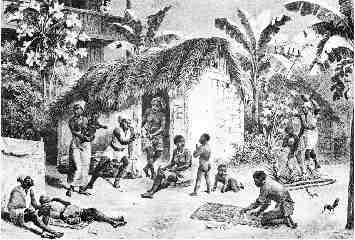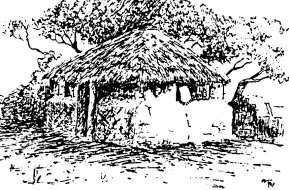

AN 18TH CENTURY SLAVE YARD
AN EARLY 2OTH CENTURY ANTIGUAN & BARBUDAN WATTLE HOUSE
|
LIFE AT BETTY'S HOPE |
 |
 |
|||
|
|
AN 18TH CENTURY SLAVE YARD |
|
AN EARLY 2OTH CENTURY ANTIGUAN & BARBUDAN WATTLE HOUSE |
|
|
THE HOUSES Even in the 1940's conditions of extreme poverty existed in Antigua. The people's rural cottages were made of wattle and daub: woven sticks plastered with mud and roofed with cane trash. It was not unusual for a family of six to eight to inhabit these cramped one-roomed dwellings. Often the floors were bare earth, which sometimes hosted biting insects called jiggers. Clothes were supplemented with articles made with burlap sacks, known locally as crocus bags. Later, old flour bags were used. House wares were of folk pottery and the hollowed out shell of the calabash gourd. A smoky light was obtained from a rag stuffed in a bottle of kerosene oil, called a flambeau. Working hours were long, from 6 am to 5 pm. Devoid of sanitary facilities, it does not take too much imagination to appreciate the unhealthy and socially impoverished situation which prevailed under such living conditions. It was when two hurricanes ravished Antigua and Barbuda in 1951, that most of the wattle and daub cottages were blown down, never to be rebuilt. The 1950's did indeed begin to show a new awakening for Antiguans and Barbudans in their work and living conditions. Old time Antiguan names for these cottages were: 'Trash Houses' and 'Stand back 'n Fire'. |
|
|
IN THE CANE FIELDS At each sugar estate there was a manager and a stock overseer, the latter was responsible for the welfare of the animals. Next to these senior estate officers, there was a head carpenter, a head blacksmith and a head wheelwright. Each category carried with it, its own social recognition and status as a craftsman. Then there were many classes of labourers: weeders, forkers, ploughmen, cartmen, water carriers, cattle minders and many others. The manager gave his orders to the senior overseer, who shared them with his junior overseers, who in turn passed them on to the labourers. The labourers were usually divided into gangs, which were supervised by :drivers". Over all the drivers were the rangers, who were most feared and revered. On Fridays, the rangers rode through the fields to assess the work of the labourers for the week, and according to this evaluation handed to the overseers, the men were paid.. Consequently the labourers were continually at odds with the high and mighty rangers. Much of the hue and cry brought about the disturbances of 1918, centered around one particular ranger, but this particular trouble was not centered around Betty's Hope estate. |
|
|
|
LIFE OF A LABOURER IN THE 1940's GiGi was a resident of Pares Village and was born there. She worked at Betty’s Hope from the age of 15 yrs for very small wages, 6d a day and worked from 7am - 4pm from Monday to Saturday. Lunch was from 11 to 12. Her mother and grandmother also worked there. If they didn’t turn out one day, and they lived there, they would take out the door and windows of the “Nega houses” and leave them living like cattle in a pen. You have to turn out to work every day, carn’t miss that unless you’re really really sick and sometime they say really sick mananger ride their harse and come by where you live and find out if you’re inside and you answer an’say ‘Yes Massa! Its Massa we hav’ to call dem...Everyting ‘Yes and No Massa!’. Carn’t jus’ call dem by der name, no sir!
The masters were very hard. There was a gentleman
living there they called Major Ledeatt and he was very hard upon people so
that they “met some rough time”. ”The mill was working there and they pushed the cane in through a hole like when they baking bread, can’t push your hand in too far else you get damaged. You have to keep pushing the cane, and heap the megasse”. They had to help growing the cane, “We had to do plenty of rows, two dozen rows. Rows were 1/8d a week and 2/6d for planting, 1/8d for ratoon. When the cane done cut off they call it the ratoon. When you cut the cane for go to the mill they call that fielding or ratoon”. They had to arrange the trash and put on the bank. “If you don’t turn out aday to do it, they complain you and carry you to court. We spread manure, scum, and bring it from the factory after dey done wid de sugar and they bring the megasse and shoot it in the field, got to spread it out”. They had to make ‘cane hole’. “Plenty different work”. The two mills are still there. “Slavery building you can’t mash down”, they are very strong. There were two “Buffs” but the other day one burned down, but the form of it is still there. “And at Betty’s Hope there used to be a lot a nega house, where the people did live, this is where they came to take down the windows and doors if you did not turn out to work”.
“The last manager that worked there was Jimmy Gore,
but he dead now too, he was living there the last days in the 1940’s, in
1948 and them so, he worked der. He dead in ‘56, so the next one come, Mr.
Bell”. Let me tell you, evergreen trees and all, all different nice trees. Nice trees that white people would like, you know, but now they want clear out. Jack-a-Lantern is an Jumbie. Bad people in dem days that do plenty a bad, say they turn into Jack-a-Lantern when dem dead. Dem deal wid de debil so much dat dem just turn dat when dem dead, and bother human. One house over by de Cotton dey, and some people dat live dere, Miss Charles and dem, well we just have to go Parham to get food an so, ‘cause no shop is nearby. So, we go Parham an when we gone, Jack-a-Lantern go dey and scream de house wid dere light, out for dem light, de little kerosene lamp light, dey out dem, an de pick-a-negga start for bawl murder! Plenty children bawling murder, an in de murder bawlin, de farder and mudder come in on donkey from Parham and get de Jumbie to run...dey protect dem children. Dat not dere now because so much a car, nutting like that out dere now and dey gone, scamp get too much a car, to an from, up an down, east and west. Can’t stand that now, so nobody really a hear nothing about dat now, dem just gone..diminish, yes”. Jack-a-Lantern get cut out when motor car get so popular in Antigua. Dey used to come right out by the corner on the straight road to the west. Bother people plenty, man could hardly pass going Willikies or Seaton. Before time we had to walk with donkey an harse, we never have car like we have now, so it just trouble sometime we reach, we have to run back bawl murder - for help! (giggles) barl murder Jack-a-Lantern scream you ‘round because we don’t have bright light like we have now - you could stop at the village and look up an’ see! And Jack-a-Lantern come from Betty’s Hope to a big tower just by the old Cotton (tree) dere, and he roam from dere to Betty’s Hope pillar. In July 1964 a cartman, drunk, sped his cart with 17 workers in it at such a speed that it overturned. Gigi was the only one hospitalised, with a broken pelvis and a fractured hip. GiGi lived at Betty’s Hope from childhood up to the time “when the Syndicate mash up and Moody-Stuart sell to the Government of Antigua and that was in ‘66... Mr.Bird got to go to England to get it to buy the whole Syndicate over...after that it was Government place remember that!” Three room house is still dere. GiGi said that Douglas Thibou who worked at Betty’s Hope, still lives in Pares and would know plenty about the estate. Things changed after the estate got a loader. Then we had to start at 6am. We would pick up what the loader dropped. Betty’s Hope was a nice place “because anything you plant you could redeem benefit from it, without them lock you up or nothing...always have a meal from it, because they always have food planted at Betty’s Hope and Garden. You could redeem anything, eddoes, corn, sweet potatoes anything that can go in a pot for make one meal”. Some other of the provisions grown at Betty’s Hope were pigeon peas, “so although we really living there you could really get a meal off of dem different tings, because the maninger and them does really make the people that work plant them and you could get a lot even for carry to your home, for mek a meal together. The home right there on the estate...Betty’s Hope was a lot of house, some was store room”. There was also a long house that had a series of rooms, in which people lived in. Some lived in single house, mostly store room house. Betty’s Hope is a nice place, I always say it is a pity for just run into the copse, run in bush, but Betty’s Hope was really nice place, also just the other day the last Buff burn down. Me glad if you can do something over dey! Everybody just dead den jus’ lift up everyting and let everyting go jus’so. The Museum of Antigua & Barbuda has many other oral histories, including one by Sir George Walter. We would like many more about the life of the old people. |
|